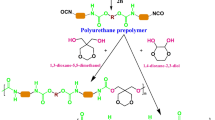Abstract
Biodegradable segmented poly(ester-urethane)s derived from telechelic dihydroxy-poly[(R)-3-hydroxybutyrate], acting as hard segments, and poly(ε-caprolactone)-diols, acting as soft segments, using 1,6-hexamethylene diisocyanate, as non toxic connecting agent, were synthesized. The copolymers were characterized with regard to their molecular weight by GPC and their main thermal transitions by DSC. These copolymers as well as PHB were exposed to UV-irradiation for different time intervals and the changes in the chemical structure were analyzed by FTIR spectroscopy. Under our experimental conditions, it was found that the increase of irradiation time was accompanied by increase of the proportion of the gel fraction and the decrease of the intrinsic viscosity of the soluble fraction of the investigated copolymers. The biodegradability of PHB and poly(ester-urethane) sample containing ~40 wt% PHB before and after UV-irradiation was investigated under soil burial. The results showed that the photolysis in air prior to biodegradation increased the rate of degradation.













Similar content being viewed by others
References
Alber R, Lundgren DG, Marchessault RH, Cote WA (1963) Biopolymers 1:545. doi:10.1002/bip.360010605
Lundgren DG, Alber R, Schnaitman C, Marchessault RH (1965) J Bacteriol 89:245. doi:10.1002/path.1700890125
Doi Y (1990) Microbial Polyesters. VCH Publishers, New York
Anderson AJ, Dawes EA (1990) Microbiol Rev 54:450
Sasikala C, Ramana CV (1996) Adv Appl Microbiol 42:97. doi:10.1016/S0065-2164(08)70373-3
Suriyamongkol P, Weselake P, Narine S, Moloney M, Shah S (2007) Biotechnol Adv 25:148. doi:10.1016/j.biotechadv.2006.11.007
Pijuan M, Casas C, Baeza JA (2009) Process Biochem 44:97. doi:10.1016/j.procbio.2008.09.017
Verhoogt H, Ramsay BA, Favis BD (1994) Polymer (Guildf) 35:515. doi:10.1016/0032-3861(94)90465-0
Savenkova L, Gercberga Z, Nikolaeva V (2000) Process Biochem 35:573. doi:10.1016/S0032-9592(99)00107-7
Grassie N, Murray EJ, Holmes PA (1984) Polym Degrad Stabil 6:48. doi:10.1016/0141-3910(84)90075-2
Grassie N, Murray EJ, Holmes PA (1984) Polym Degrad Stabil 6:95. doi:10.1016/0141-3910(84)90075-2
Gonzalez A, Irusta L, Ferna’ndez-Berridi MJ, Iriarte M, Iruin JJ (2005) Polym Degrad Stabil 87:347. doi:10.1016/j.polymdegradstab.2004.09.005
Loo CY, Sudesh K (2007) Int J Biol Macromol 40:466. doi:10.1016/j.ijbiomac.2006.11.003
Trotsenko YA, Belova LL (2000) Microbiol 69:635. doi:10.1023/A:1026641821583
Choi MH, Lee HJ, Rho JK (2003) Biomacromolecules 4:38. doi:10.1021/bm025596s
Saito Y, Doi Y (1994) Int J Biol Macromol 16:99. doi:10.1016/0141-8130(94)90022-1
SU F, Iwata T, Tanaka F, Doi Y (2003) Macromolecules 36:6401. doi:10.1021/ma034546s
Tsuge T, Kikkawa Y, Doi Y (2004) Sci Technol Adv Mater 5:449. doi:10.1016/j.stam.2004.01.013
Tsuge T, Saito Y, Kikkawa Y (2004) Macromol Biosci 4:238–242. doi:10.1002/mabi.200300077
Ha C, Cho W (2002) Prog Polym Sci 27:759. doi:10.1016/S0079-6700(01)00050-8
Reeve MS, McCarthy SP, Gross RA (1993) Macromolecules 26:888. doi:10.1021/ma00057a002
Hirt TD, Neuenschwander P, Suter UW (1996) Macromol Chem Phys 197:4253. doi:10.1002/macp.1996.021971221
Lendlein A, Neuenschwander P, Suter UW (1998) Macromol Chem Phys 199:2785. doi:10.1002/(SICI)1521-3935(19981201) 199:12<2785::AID-MACP2785>3.0.CO;2-X
Saad GR, Lee YJ, Seliger H (2002) J Appl Polym Sci 83:703. doi:10.1002/app.2265
Impallomen G, Giuffrida M, Barbuzzi T, Musumarra G, Ballisteri A (2002) Biomacromolecules 3:835. doi:10.1021/bm025525t
Saad GR (2001) Macromol Biosci 1:387. doi:10.1002/1616-5195(20011201) 1:9<387::AID-MABI387>3.0.CO;2-4
Saad GR, Seliger H (2004) Polym Degrad Stabil 83:101. doi:10.1016/S0141-3910(03)00230-1
Hamid SH (2000) Handbook of Polymer Degradation. Marcel Dekker, New York
Feldman D (2002) J polym Envirom 10:163
Lucas N, Bienaime C, Belloy C, Queneudec M, Silvestre F, Nava-Saucedo J-E (2008) Chemosphere 73:429–442. doi:10.1016/j.chemosphere.2008.06.064
Grima S, Bellon-Maurel V, Feuilloley P, Silvestre F (2000) J Polym Envirom 8:183. doi:10.1023/A:1015297727244
Reeve MS, McCarthy SP, Gross RA (1990) Am Chem Soc Div Polym Sci 30:473
Barham P, Keller AJ, Otuun EL, Holmes PA (1984) J Mater Sci 19:2781. doi:10.1007/BF01026954
Crescenzi V, Manzini G, Calzolari G, Borri C (1992) Eur Polym J 8:449. doi:10.1016/0014-3057(72)90109-7
Wilhelm C, Gardette JL (1997) Polymer (Guildf) 38:4019. doi:10.1016/S0032-3861(96)00984-6
Irusta L, Fernandez-Berridi MJ (1999) Polym Degrad Stabil 63:113. doi:10.1016/S0141-3910(98)00073-1
Ikada E (1997) J Photopolym Sci Technol 10:265. doi:10.2494/photopolymer.10.265
Author information
Authors and Affiliations
Corresponding author
Rights and permissions
About this article
Cite this article
Saad, G.R., Khalil, T.M. & Sabaa, M.W. Photo- and bio-degradation of poly(ester-urethane)s films based on poly[(R)-3-Hydroxybutyrate] and poly(ε-Caprolactone) blocks. J Polym Res 17, 33–42 (2010). https://doi.org/10.1007/s10965-009-9287-6
Received:
Accepted:
Published:
Issue Date:
DOI: https://doi.org/10.1007/s10965-009-9287-6




